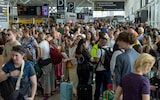A high-powered laser weapon capable of shooting down aerial drones has been fired from a British military vehicle for the first time.
Raytheon’s high-energy laser weapon system (HELWS) was mounted on a British Army Wolfhound armoured truck for the test-fire, which took place at the Government’s Porton Down science and defence technology campus in Wiltshire.
It is the first time the weapon has been trialled in the UK as part of an ongoing Ministry of Defence (MoD) programme to develop directed energy weapons.
HELWS, which is already cleared for use by the US military, is designed to shoot down small drones and be compatible with existing air defence systems such as radar.
Developing anti-drone systems is increasingly important as low-cost weapons become more common on the battlefield. For example, Russia and Ukraine have relied heavily on drones to launch attacks on one another.
British and American ships were recently forced to fire multimillion-pound missiles to shoot down inexpensive unmanned drones launched by Houthi rebels on the Red Sea.
Shooting down drones with lasers, which cost far less per shot than the drones themselves, offers a much cheaper solution.
James Gray, chief executive and managing director of Raytheon UK, said: “We have proven that the Raytheon high-energy laser weapon system can track and engage targets whilst mounted on a vehicle.
“The speed at which this capability was delivered is only possible due to the hard work of our British partners, coupled with the operationally proven technology developed by Raytheon.”
UK-based companies including Frazer Nash, NP Aerospace, LumOptica, Blighter Surveillance Systems and Cambridge Pixel contributed technology to the project.
The test comes after the MoD demonstrated Dragonfire, another laser weapon that the Navy hopes to mount on to warships by 2027.
Dragonfire was developed by a consortium including MBDA, Leonardo and QinetiQ.
Raytheon’s HELWS is being developed in partnership with the Defence Science and Technology Laboratory (DSTL) and Defence Equipment and Support (DE&S), which are both part of the MoD.
Matt Cork, of DSTL, said: “The joint working between DSTL, DE&S and industry has enabled rapid evolution of this laser demonstrator.
“The successful testing of this high-powered laser weapon marks a pivotal moment in our ongoing efforts to enhance the future operational capabilities of the British Army.
He added: “This technology offers a precise, powerful and cost-effective means to defeat aerial threats, ensuring greater protection for our forces.”
Disclaimer: The copyright of this article belongs to the original author. Reposting this article is solely for the purpose of information dissemination and does not constitute any investment advice. If there is any infringement, please contact us immediately. We will make corrections or deletions as necessary. Thank you.



